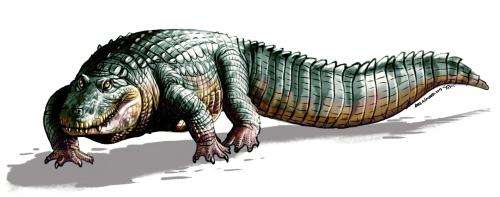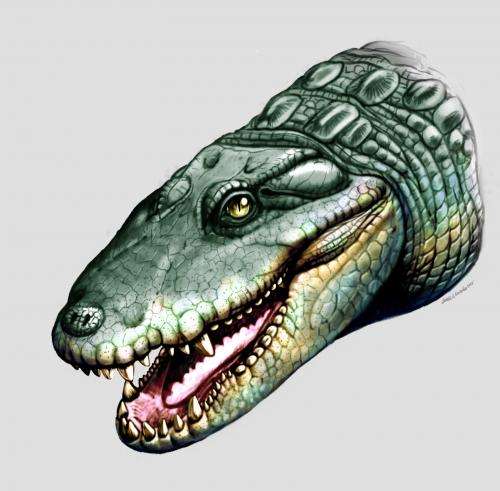14 closely related crocodiles existed around five million years ago

14 species of crocodile lived in South America around 5 million years ago, at least seven of which populated the coastal areas of the Urumaco River in Venezuela at the same time. Paleontologists from the University of Zurich have found evidence of an abundance of closely related crocodiles that remains unparalleled to this day. As they were highly specialized, the crocodiles occupied different eco-niches. When the watercourses changed due to the Andean uplift, however, all the crocodile species became extinct.
Nowadays, the most diverse species of crocodile are found in northern South America and Southeast Asia: As many as six species of alligator and four true crocodiles exist, although no more than two or three ever live alongside one another at the same time. It was a different story nine to about five million years ago, however, when a total of 14 different crocodile species existed and at least seven of them occupied the same area at the same time, as an international team headed by paleontologists Marcelo Sánchez and Torsten Scheyer from the University of Zurich is now able to reveal. The deltas of the Amazonas and the Urumaco, a river on the Gulf of Venezuela that no longer exists, boasted an abundance of extremely diverse, highly specialized species of crocodile that has remained unparalleled ever since.
Two new fossil crocodile species discovered
While studying the wealth of fossil crocodiles from the Miocene in the Urumaco region, the scientists discovered two new crocodile species: the Globidentosuchus brachyrostris, which belonged to the caiman family and had spherical teeth, and Crocodylus falconensis, a crocodile that the researchers assume grew up to well over four meters long. As Sánchez and his team reveal, Venezuela's fossils include all the families of crocodile species that still exist all over the world today: the Crocodylidae, the so-called true crocodiles; the Alligatoridae, which, besides the true alligators, also include caimans; and the Gavialidae, which are characterized by their extremely long, thin snouts and are only found in Southeast Asia nowadays.

On account of the species' extremely different jaw shapes, the researchers are convinced that the different crocodilians were highly specialized feeders: With their pointed, slender snouts, the fossil gharials must have preyed on fish. "Gharials occupied the niche in the habitat that was filled by dolphins after they became extinct," Sánchez suspects. With its spherical teeth, however, Globidentosuchus brachyrostris most likely specialized in shellfish, snails or crabs. And giant crocodiles, which grew up to 12 meters long, fed on turtles, giant rodents and smaller crocodiles. "There were no predators back then in South America that could have hunted the three-meter-long turtles or giant rodents. Giant crocodiles occupied this very niche," explains Scheyer.
Andean uplift led to extinction
The unusual variety of species in the coastal and brackish water regions of Urumaco and Amazonas came to an end around 5 million years ago when all the crocodile species died out. The reason behind their extinction, however, was not temperature or climate changes – temperatures in the Caribbean remained stable around the Miocene/Pliocene boundary. Instead, it was caused by a tectonic event: "The Andean uplift changed the courses of rivers. As a result, the Amazon River no longer drains into the Caribbean, but the considerably cooler Atlantic Ocean," explains Sánchez. With the destruction of the habitat, an entirely new fauna emerged that we know from the Orinoco and Amazon regions today. In the earlier Urumaco region, however, a very dry climate has prevailed ever since the Urumaco River dried up.
More information: T. M. Scheyer, O. A. Aguilera, M. Delfino, D. C. Fortier, A. A. Carlini, R. Sánchez, J. D. Carrillo-Briceño, L. Quiroz, and M. R. Sánchez-Villagra. Crocodylian diversity peak and extinction in the late Cenozoic of the northern Neotropics. Nature Communications. May 21, 2013. doi:10.1038/ncomms2940
Journal information: Nature Communications
Provided by University of Zurich




















